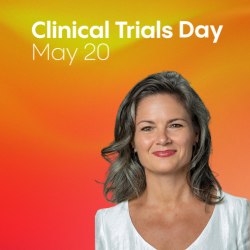This is a sponsored message.
Every May 20th, our community celebrates Clinical Trials Day. It was on this day in 1747 when Dr. James Lind conducted what is largely considered to be the first clinical trial, testing different treatments for scurvy among sailors aboard a ship and reliably proving the therapeutic solution of vitamin C. Even so, the British Navy did not adopt the innovation until nearly two centuries later.
The science was evidentiary, and the results were immediate. But the adoption was painfully slow. Of course, we know a lot more about science and conducting safe and successful clinical trials than we did 300 years ago. Our community has eradicated vicious diseases like smallpox, and found cures for hundreds of other conditions, from polio to tuberculosis. For that, we should feel immensely proud.
On this 19th Clinical Trials Day, I find myself pondering everything we still do not know, and everything we have yet to achieve in clinical research. From my many years of experience running clinical trial sites, I recognize the unfortunate reality that trials are too expensive and too slow – which has a real, human cost. And I am reminded of a woman who was featured at Advarra’s recent Onsemble Conference who is suffering from ALS – a disease that was discovered in 1869. She heartbreakingly said, “I am relying on the same medication Lou Gehrig took more than 80 years ago! We need to do better.”
What could we accomplish in the next decades if we could clear away the barriers and break down the silos that still plague clinical research?
I’m choosing to face these questions not with dismay, but with determination. As clinical research professionals, we know what we must do to improve efficiency and get drugs to patients faster. Here’s where I believe our community should focus our efforts this year:
- Improving feasibility
The current feasibility process feels downright prehistoric. We can change that by enhancing feasibility forms through increased automation and reduced redundancy. Additionally, a shift towards longer-term forethought rather than rushed, short-term milestones could mitigate problems like inaccurate enrollment projections and protocol deviations. Collaborative efforts between sites and sponsors to refine feasibility processes also offer a promising avenue for expediting trial timelines and improving overall efficiency. Simple things like previewing feasibility forms with experienced site teams ahead of distribution, retaining basic information on forms to avoid redundant data entry, and ensuring the form accurately reflects thorough inclusion/exclusion criteria would hit all the marks by being easy to accomplish, meaningful to sites in the amount of time saved, and cost-beneficial for sponsors because of the more accurate enrollment projections.
2. Ironing out financials
When it comes to finances, more effort should be made to reduce friction, increase visibility, and foster stronger relationships between sites, CROs, and sponsors. First, of course, sites shouldn’t have to struggle to be paid on time. But there are other inefficiencies at play that sites have more control over, such as transactional models that vary between sponsors, customers, and sites. Sites can also try to negotiate milestone-based contracts, which might include upfront mobilization fees or enrollment completion bonuses, to help boost trial momentum. For their part, large clinical research organizations (CROs) and sponsors might consider establishing consistent financial frameworks across their portfolios.
3. Building trust in clinical trials – with patients and providers alike
Another longstanding challenge in our community is finding patients for our trials. Time and time again during my site days, I heard from prospective subjects that they didn’t want to be “guinea pigs,” or from physicians that they didn’t want to take any risks. We have to admit that our community – and medicine in general – has fallen short when it comes to marketing our mission and all the good that can be gained from it. In a recent survey of random U.S. residents, only 13% had ever participated in a trial, and only 20% had been offered participation in a trial by their healthcare provider.
Here, again, better collaboration within the clinical trials ecosystem can help: it’s imperative for sites, CROs, and sponsors alike to do all we can to make clinical trials seem like an opportunity for all participants. In practice, this could look like education and outreach with clear and accessible information; better collaboration with physicians and patient advocacy groups; stronger community engagement; a bigger focus on patient testimonials; hiring lobbyists to communicate the importance of trials for better, faster, and less expensive healthcare; and any number of creative marketing campaigns our community has yet to embark upon.
4. Streamlining site technologies
Lastly, we should strive to use technology in ways that streamline processes and break down silos, rather than create unnecessary burdens. Sponsors are increasingly adopting technologies to improve trial systems and workflows, and these tools have indeed improved data collection and aided new trial modalities such as decentralized trials, among other gains.
However, the proliferation of tools has also introduced significant new burdens on sites. According to Advarra’s 2023 Study Activation Survey Report, the average oncology study can require a site to access 22 different systems. Imagine the set-up and training needed for these systems, let alone the daily logins required when multiple studies are accessed daily. This technology burden has emerged as a greater headache than traditional challenges like contracting and budgeting. We should strive to streamline access and integrate these technologies where we can so they help sites accelerate the discovery of lifesaving treatments, rather than increasing burden and further prolonging trial timelines.
Despite the obstacles we still face, let’s celebrate Clinical Trials Day more motivated than ever. We should look back at how far we have come and the lives our industry has impacted. We should also recognize that looking back can help us see forward as we tackle these ongoing challenges as a community. Through increased collaboration, we can lay the foundations for tomorrow’s health revolutions, today — so that decades and centuries from now our successors in research can look back and reflect upon an era of dramatic improvement characterized by innovation in both science and speed.
About the Author
Christine Senn, PhD, FACRP, is the SVP of Site-Sponsor Innovation at Advarra, a global company offering services and technology solutions to safeguard trial participants and enable collaboration across all industry domains. She has worked in clinical research since 2005, starting at the University of Vermont College of Medicine followed by Centricity Research, where she served in various business roles across strategic growth initiatives, project planning and execution, and continuous process improvement. Senn has a PhD in psychology and master’s degrees in clinical psychology and advertising and public relations. She was the 2023 Chair of the Association of Clinical Research Professionals (ACRP), is an ACRP Fellow (FACRP), and is double certified as a Certified Clinical Research Coordinator (CCRC) and Certified Principal Investigator (CPI). Senn can be reached at Christine.senn@advarra.com.




